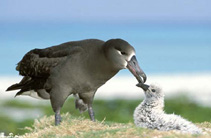Phoebastria nigripes (Audubon, 1839)
Black-footed albatross
Классификация / Names народные названия | синонимы | CoL | ITIS | WoRMS
Aves | Procellariiformes | Diomedeidae
Environment: milieu / climate zone / пределы глубины / distribution range экология
. Subtropical
Distribution страны | регионы FAO | Ecosystems | места находок | интродукции
Pacific Ocean and Northwest Atlantic: from the coasts of China, Japan and Russia eastward to continental North America. Tropical to temperate waters.
Length at first maturity / Size / Weight / Возраст
половая зрелость: Lm ? range ? - ? cm Max length : 81.0 cm TL самец/пол неопределен; (ссылка 84934); наибольший вес (опубликованные данные): 3.0 kg (ссылка 356)
Краткое описание морфология
Life cycle and mating behavior половая зрелость | размножение | нерест | Eggs | Fecundity | Larvae
Основная ссылка
ссылки | координатор | соавторы
Lepage, D. 2007 Avibase -the World Bird Database. http://www.bsc-eoc.org/avibase/avibase.jsp [accessed 09/07/2007]. (ссылка 7816)
Статус Красного Списка МСОП
(ссылка 130435: Version 2025-1)
Статус СИТЕС (ссылка 108899)
CMS (ссылка 116361)
Угроза для людей
Использование человеком
| FishSource |
инструменты
дополнительная информация
ресурсы в Интернет
BHL | BOLD Systems | CISTI | DiscoverLife | FAO(Publication : search) | Fishipedia | GenBank (Геном, Нуклеотид) | GloBI | Gomexsi | Google Books | Google Scholar | Google | PubMed | Tree of Life | Wikipedia (Вперёд, поиск) | Zoological Record



